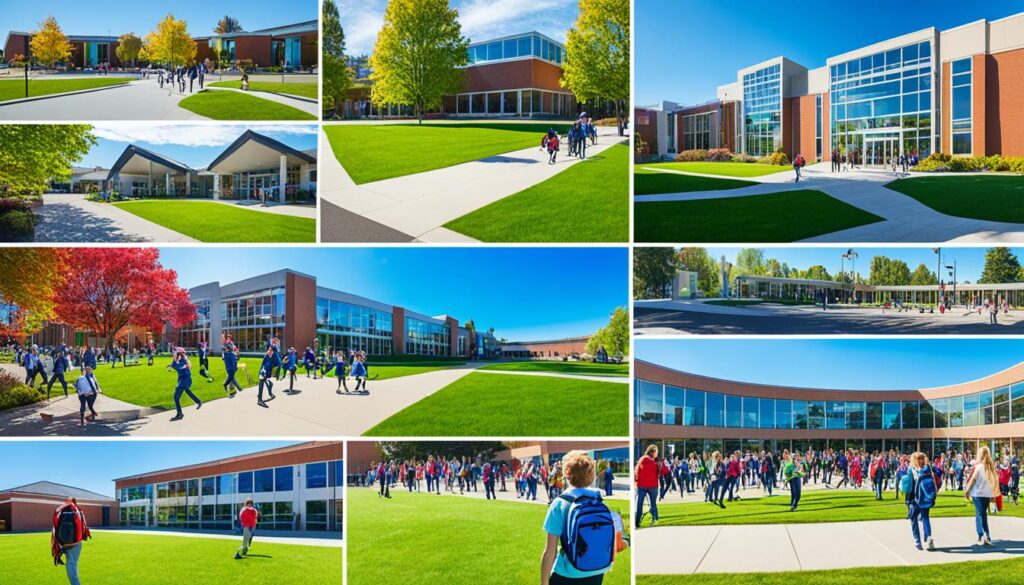Finding the right school in Argentina is crucial for families, especially expatriates seeking quality education for their children. With a literacy rate exceeding 98% and a robust educational system encompassing primary, secondary, and tertiary levels, Argentina is home to a variety of educational options. Particularly in Buenos Aires, there are numerous top schools that cater to diverse needs, including international schools offering multicultural experiences and bilingual education programs12.
As families transition to life in Argentina, understanding the local education landscape is essential. This guide aims to provide insightful information about the Argentine education system, focusing on the characteristics of international schools in Buenos Aires, the structure of bilingual education, and important factors to consider when selecting a school. By exploring these aspects, expat families can make informed choices that align with their educational values and aspirations for their children13.
Key Takeaways
- Argentina’s literacy rate is over 98%, reflecting a strong educational foundation.
- International schools in Buenos Aires offer various curricula, including IB and British systems.
- Bilingual education is increasingly popular, often consisting of 50% instruction in English.
- Parents should plan applications in advance due to waiting lists at top schools.
- Understanding the local education system’s structure is crucial for expat families.
Unlock Investment Opportunities
Introduction to Education in Argentina
Education in Argentina is a rich tapestry influenced by its diverse culture and history, featuring both public and private institutions that cater to the needs of local and expatriate communities. The establishment of compulsory education dates back to 1869, highlighting the nation’s commitment to nurturing future generations4. In terms of student enrollment, around 11.4 million individuals were enrolled in various educational levels in 2005, illustrating the extensive participation in formal education5.
For expats, navigating the education in Argentina can seem daunting due to the nuances of the schooling system. Factors such as language offerings, curriculum variations, and cultural differences can significantly impact international families anticipating schooling for expats. The academic year spans from March to December, encompassing about 200 school days, during which public elementary schools operate for four and a half hours each weekday6.
Approximately 400 private schools existed as of 2001, with a third being private and Catholic, showcasing the prevalence of alternative education options for families4. With steady government investment in education, reaching over US$14 billion in 2007, the sector has seen significant growth in opportunities and institutional diversification, further benefiting both local students and expat families seeking quality education5.
The Argentine Education System Overview
The Argentine education system is characterized by its compulsory education structure, ensuring that students receive quality education from an early age.
Preprimary education begins as early as 45 days old and lasts through the age of 5, varying in duration from 1 to over 5 years. Primary education typically covers students aged 6 through 11 or 12, spanning 6 to 7 years. Following primary school, students proceed to lower secondary education, which accommodates ages 12 or 13 to 14 for a period of 2 to 3 years. Upper secondary education is designed for ages 15 through 17 and lasts for 3 years, with entrance contingent upon passing the last year of lower secondary education. This structure reflects the types of schools in Argentina, which include public, private, and international institutions.
The education spending in Argentina reached 5.87 percent of GDP in 2015, falling short of the mandated 6 percent, indicating some budgetary constraints within the system7. Argentina boasts a high net enrollment rate in tertiary education, coming second only to Chile in South America as of 20157. Conversely, the country struggles with dropout rates, particularly at the tertiary level, where only 27 percent of students completed their studies in 20107.
Within the Argentine education system, there is flexibility in structuring primary and secondary education, allowing for variations based on regional needs. The system is regulated at a national level, yet funding and administrative practices differ across various types of schools in Argentina, which can impact overall education quality. State-run universities offer tuition-free education up to the graduate level, contrasting sharply with private institutions that may impose significant costs on families.
Despite facing challenges like economic volatility, the Argentine education system maintains a strong focus on language proficiency, with many students exhibiting high English skills. The educational landscape is shaped by a desire for international experience, driving demand for programs in finance and law among students, who represent a growing population of international learners in the country source.
| Education Level | Age Group | Duration |
|---|---|---|
| Preprimary | 45 days to 5 years | 1 to more than 5 years |
| Primary | 6 to 11/12 years | 6 to 7 years |
| Lower Secondary | 12/13 to 14 years | 2 to 3 years |
| Upper Secondary | 15 to 17 years | 3 years |
| Tertiary | Varies by program | Variable (often 4-5 years) |
The educational trajectory in Argentina vividly illustrates the interplay of different educational levels, contributing to a nuanced understanding of how the Argentine education system functions.
Top International Schools in Buenos Aires

Buenos Aires is home to a diverse range of international schools, catering to the educational needs of expat families. Parents often seek out these institutions due to their ability to offer curricula aligned with North American and European standards, which allows children to transition smoothly into their new academic environment. The international schools in Argentina often provide bilingual, trilingual, or even English-only programs while incorporating local educational standards.
Characteristics of International Schools
International schools in Buenos Aires are characterized by several key features. They typically offer:
- Smaller class sizes to ensure personalized learning.
- A strong emphasis on extracurricular activities that foster community engagement.
- Flexible curricula, including British, American, French, and International Baccalaureate programs.
- A multicultural environment that supports integration for children from diverse backgrounds.
There are currently approximately 30 international schools in Buenos Aires, including notable institutions such as the Buenos Aires International Christian Academy and St. Andrew’s Scots School, which collectively serve several hundred students from various nationalities. St. Andrew’s Scots School provides bilingual education for around 2,000 students and prepares them for International Baccalaureate exams8.
Notable International Schools in Buenos Aires
Among the top schools in Buenos Aires, several stand out due to their educational offerings and community reputation:
- Northlands School: This co-educational bilingual IB World School emphasizes moral values and respect for diverse cultures.
- Goethe-Schule: With a rich history dating back to 1897, it offers a curriculum that includes the German International Baccalaureate.
- Lincoln School: Catering to students from preschool to Grade 12, Lincoln combines Argentinian, American, and International Baccalaureate programs to provide a well-rounded education.
Transitional challenges for expat families are eased through these educational establishments, which aim to create a supportive community910. Overall, the array of international schools in Buenos Aires reflects the city’s commitment to multicultural education, providing enriching options for families relocating to the area.
Unlock Investment Opportunities
Understanding Bilingual Education in Argentina

Bilingual education in Argentina has become a prominent aspect of the educational landscape, characterized by schools that provide instruction in both Spanish and a foreign language, predominantly English. This format not only enhances language acquisition but also enriches students’ overall educational experience. The pioneering institution in this realm, St. Andrew’s Scots School, has approximately 1,900 students engaged in a fully bilingual curriculum, integrating Spanish instruction since its founding in 186011. As of now, bilingual education encapsulates 80% of English-Spanish bilingual schools centered in Buenos Aires and Gran Buenos Aires, laying a solid foundation for multicultural educational frameworks12.
What Defines a Bilingual School?
A bilingual school is primarily defined by its commitment to teaching core subjects in both languages to ensure comprehensive language competence. Typically, around 50% of tuition time is allocated to each language, promoting a balanced bilingual education. Schools like St. Hilda’s College cater to students aged 2–18, preparing them for advanced qualifications such as the Advanced International Certificate of Education (AICE)13. Instruction within these schools aims to effectively blend cultural and linguistic immersion, fueling a more profound understanding of both languages among students.
Benefits of Bilingual Education for Expat Families
The benefits of bilingual schools for expat families are manifold. Students not only foster essential language skills but also gain critical insight into cultural integration. Programs across bilingual schools, particularly through professional development organizations like ESSARP, aim to prepare students for a global society through a curriculum rich in languages, arts, and health11. This dynamic educational environment helps children acclimatize to Argentina’s diverse culture, further enhancing their social adaptability and academic proficiency. Overall, bilingual education provides a strong framework for fostering resilience and long-term success in an interconnected world.
Factors to Consider When Choosing a School in Argentina

Choosing a school in Argentina is a pivotal decision for expat families. A key aspect of this choice revolves around language requirements and the support schools offer to integrate non-native speakers. Understanding the language support for expat students can significantly ease a child’s transition into a new educational system. Public schools in Argentina primarily teach in Spanish, which can pose challenges for children with limited proficiency in the language. Many schools, particularly international ones, provide language support programs tailored for such students, helping them to catch up and thrive academically.
Language Requirements and Support
In order to choose the right school, parents should assess the language requirements and the level of support offered to non-Spanish speakers. Some schools provide intensive Spanish language courses alongside their standard curriculum, ensuring that children become proficient in their new language while keeping up with academic demands. Families may find that international schools often have structured language support systems that can make the transition smoother. Understanding these dynamics will prepare families for effective choosing a school in Argentina.
Curriculum and Examination Programs
Curricular options available in Argentina are diverse, ranging from traditional Argentine programs to international curricula like the International Baccalaureate (IB) and IGCSE. The choice of curriculum can significantly impact a child’s education, especially if a family plans to move again. Public schools in Buenos Aires offer specialized programs that cover artistic and technical education, while private schools can incorporate international standards to prepare students for future academic endeavors. For families transitioning between educational systems, understanding the grading system and examination programs is vital, as Argentina employs a diverse educational framework that may differ notably from other countries1415. Ultimately, being informed about language support and curriculum types plays a crucial role in successfully navigating the educational landscape in Argentina.
School Admission Process for Foreigners

The school admission process in Argentina can be intricate for foreign families. Understanding the essential requirements and procedures is vital to ensuring a smooth transition into the educational system. It is important to note that the basic admission requirement for undergraduate programs is a certificate of school education, such as a secondary high-school-leaving certificate or its equivalent16. Non-Argentine Bachelor’s titles are also accepted for admission into Master’s and doctorate study programs when the degree is from a recognized university16.
Required Documentation for Enrollment
Enrollment documentation for international students includes various necessary papers. Applicants must provide an application form, educational transcripts, proof of language proficiency in both Spanish and English, and a statement of purpose16. Other required documentation encompasses a resume, a passport copy, professional experience certificate, recommendation letters, health insurance cover, and any necessary official recognition or revalidation of degrees16. Additionally, successful applicants will receive a letter of acceptance, which is needed for immigration purposes16.
Application Tips for a Smooth Transition
To navigate the school admission process effectively, families should keep a few tips in mind. It’s beneficial to apply to up to three programs at different institutions in one cycle, as this maximizes opportunities16. Once students receive an offer of acceptance, they should be prepared to apply for a student visa if required16. Ensuring that all documentation is translated into Spanish and submitted in a timely fashion can greatly enhance the chances of a smooth transition into the Argentinian educational system. For more comprehensive information on the requirements, visit this guide16.
Conclusion
Choosing a school in Argentina requires a thoughtful approach, especially for expat families navigating the unique landscape of education in Buenos Aires. The multitude of options, including international and bilingual schools, presents exciting opportunities for students to thrive academically and culturally. Engaging with the educational environment, understanding local customs, and considering the language of instruction are vital factors in ensuring a smooth transition.
Moreover, potential challenges such as documentation requirements must not be overlooked. Being proactive in gathering necessary papers can ease the admission process and help align expectations with the realities of top schools Argentina. This preparation, combined with a comprehensive overview of different educational philosophies and frameworks, can significantly benefit families.
Ultimately, the experience of schooling in Argentina is about more than just academics; it’s a journey of cultural integration and community involvement. By taking the time to research and assess available options, families can find the perfect educational setting that will foster both personal and academic growth.Learn more about the educational landscape in and the factors affecting student success17.
Unlock Investment Opportunities
FAQ
What are the top schools in Argentina for expatriate families?
How does the Argentine education system differ from that in the U.S.?
What are the benefits of enrolling my child in a bilingual school in Argentina?
What language requirements should I consider when choosing a school?
What international examination programs are available for students in Argentina?
What documentation do I need for enrolling my child in an Argentine school?
How can I help my child transition smoothly into a new school in Argentina?
Source Links
- https://solsalute.com/blog/bilingual-international-schools-in-argentina/
- https://www.edarabia.com/schools/argentina/
- https://www.international-schools-database.com/in/buenos-aires/top-schools-in-buenos-aires
- https://www.argentinaeducation.info/education-system
- https://en.wikipedia.org/wiki/Education_in_Argentina
- https://education.stateuniversity.com/pages/56/Argentina-EDUCATIONAL-SYSTEM-OVERVIEW.html
- https://wenr.wes.org/2018/05/education-in-argentina
- https://www.expatarrivals.com/americas/argentina/buenos-aires/international-schools-buenos-aires
- https://www.ischooladvisor.com/blog/view/top-15-best-international-schools-in-buenos-aires-argentina
- https://www.edarabia.com/schools/buenos-aires/
- https://www.tocallibeller.com/cms/wp-content/uploads/2019/02/Tocalli-Beller-in-Cummins-07.pdf
- https://www.onestopenglish.com/clil/bilingual-schools-in-argentina-has-clil-always-been-around/501045.article
- https://www.ascd.org/el/articles/bilingual-schools-in-argentina
- https://vamospanish.com/discover/english-schools-for-children-in-argentina/
- http://www.travelsur.net/forum/messages/199/2690.html
- https://www.argentinaeducation.info/admission-requirement/admission-requirements.html
- https://link.springer.com/10.1007/978-3-319-93443-3_2-1

Comments